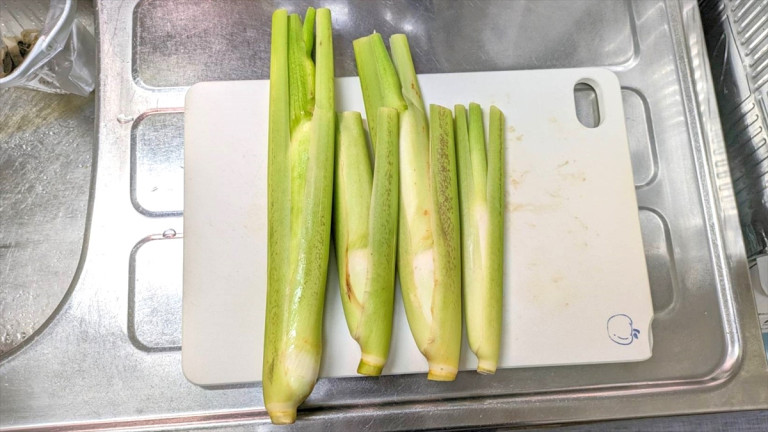
It may look like nothing special, but it’s actually the perfect vegetable to pair with anything!
Every now and then, when browsing a farmer’s market, shopping arcade, or even a supermarket you don’t usually frequent, you’ll spot food you’ve never seen before. Most people might stop and examine it for a moment, but in most cases would probably not purchase it, thinking, “I don’t know how to cook this anyway.”
But we’re here to tell you–try it! At least, try a vegetable called “makomodake”, which in English is referred to as Machurian wild rice shoots or water bamboo. Though the plant also produces grains that can be cooked like rice, the stem is edible and is a autumnal ingredient used in stir-fries, salads, and soups in Southeast and East Asia. It’s not a very common ingredient in Japan, but our Japanese-language reporter and rare-food connoisseur Haruka Takagi looks for them every fall because she absolutely loves them.
Typically she finds them at the farmer’s markets on highway rest stops (called “Michi no Eki” in Japanese) from September to November. They don’t look particularly appetizing–they honestly just look like wild grass stalks you might find growing in an abandoned field–so you may have just skipped over them if you’ve ever encountered them. They are slightly bulbous on the bottom and grow thinner on the top. When preparing to cook them, you have to first peel off the external skin to reveal the edible white flesh inside.
As a member of the Poaceae family of land grasses, the edges of the leaves can be pretty sharp, so you have to be careful when handling them. They’re much thicker than the leaves of bamboo and bamboo grass, so it really hurts if they cut you. Haruka recommends using a kitchen knife or a peeler so that you don’t have to touch them with your hands.
Once the leaves were removed, Haruka cut the stalks into thin rounds, as she planned to stir-fry them with some meat. Once you cut them, you can clearly see what looks like the vascular tissue that the plant uses to distribute water and nutrients, which is pretty cool.
Sometimes you’ll see little black dots in the flesh of the plant. These are pigment residues leftover from a parasite called smut fungus. The name might scare you, but the stalk is perfectly safe to eat, so don’t worry. However, the dots are a sign that the vegetable is going to go bad soon, so if you see them, make sure to eat your Machurian wild rice shoots sooner rather than later, lest the flavor decline.
Speaking of, the stalks don’t have any harsh or bitter flavors. In fact, they taste almost like a combination of bamboo shoots and baby corn, but also divided by two. They taste really good when paired with meat, so Haruka likes to stir-fry them with pork.
She starts her stir-fry by adding sesame oil to a pan and lightly sautéing the pork until it’s cooked through and tender.
Then she adds the Manchurian wild rice shoot slices to the pan and seasons them liberally with salt.
Once the shoots have softened, they’re ready to eat. It takes about five minutes. It’s so easy!
You can also eat the shoots raw, or boil them and top them with a sauce (mayonnaise is a popular condiment choice), but Haruka’s favorite way to eat them is stir-fried like this. They aren’t the kind of vegetable that’s rich in umami, and they have a very light flavor, so a lot of people like to dress them up with salt, soy sauce, and oyster sauce. In Haruka’s opinion, they do a great job of soaking up the fat of meat, which makes them kind of like eggplant in that way.
Stir-fried like this, they’re somewhat crunchy on the outside, with an internal softness similar to the tip of a bamboo shoot, and have no strong flavor or bitterness to them, so they’re really the perfect vegetable to pair with any dish.
Haruka also tried cooking hers meunière-style, by dredging it in flower, together with salmon, and it was insanely good. It soaked up the flavor of butter and salmon perfectly. That’s why she really recommends pairing it with some kind of fat.
At this point in the season it might be a bit hard to find Manchurian wild rice shoots, so if you do, consider yourself very lucky! Don’t be scared of its grass-like appearance and give it a try with your next dinner. In fact, don’t be scared of most food’s appearance. It probably isn’t as weird as it looks!
Images © SoraNews24
● Want to hear about SoraNews24’s latest articles as soon as they’re published? Follow us on Facebook and Twitter!
[ Read in Japanese ]

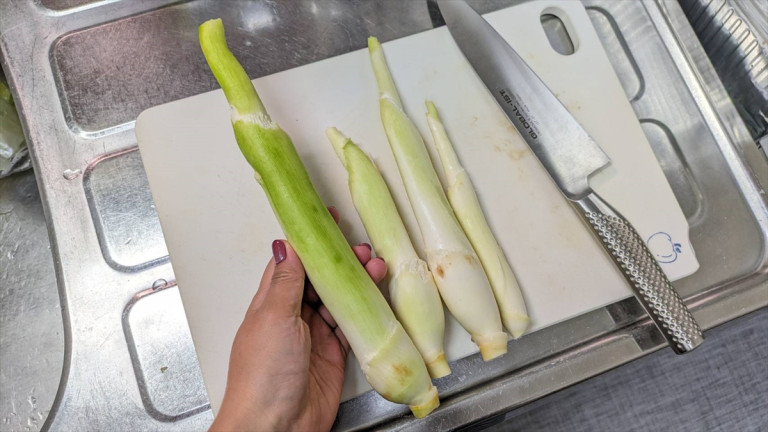
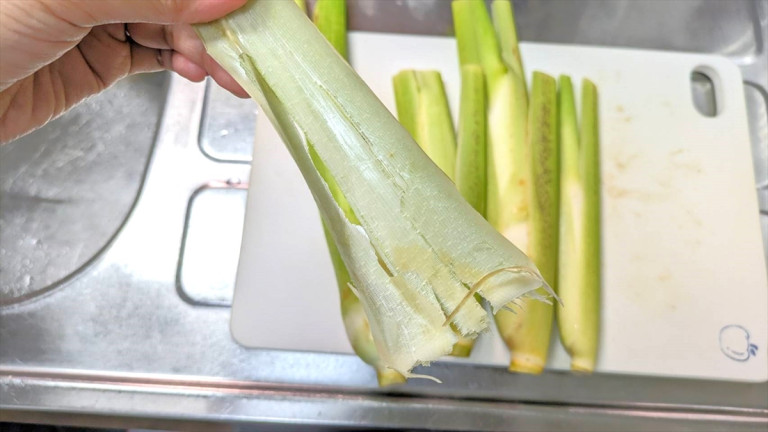
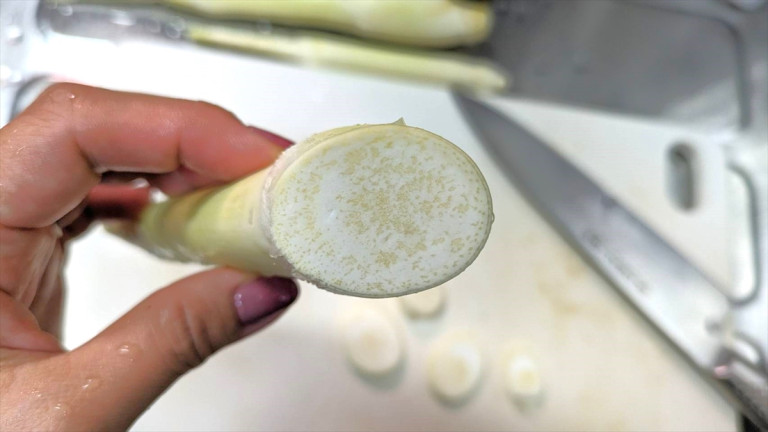
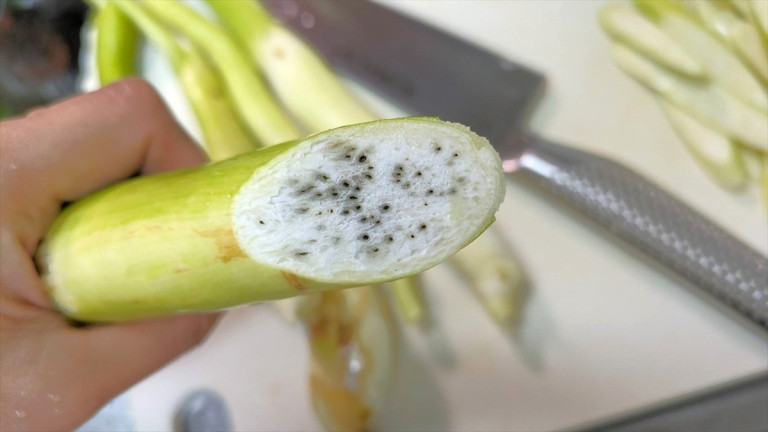
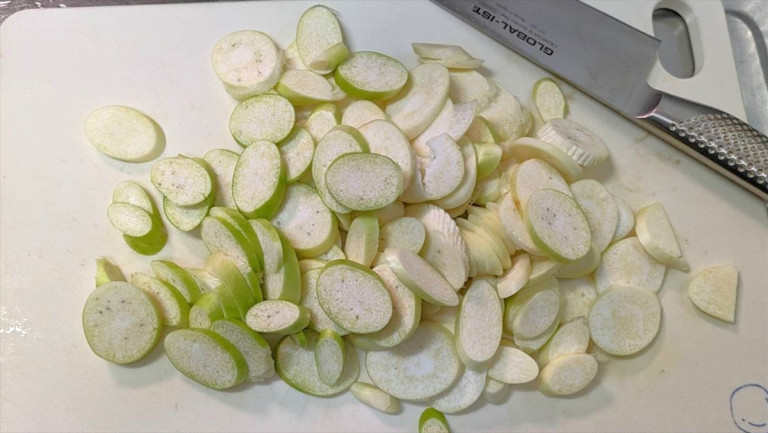
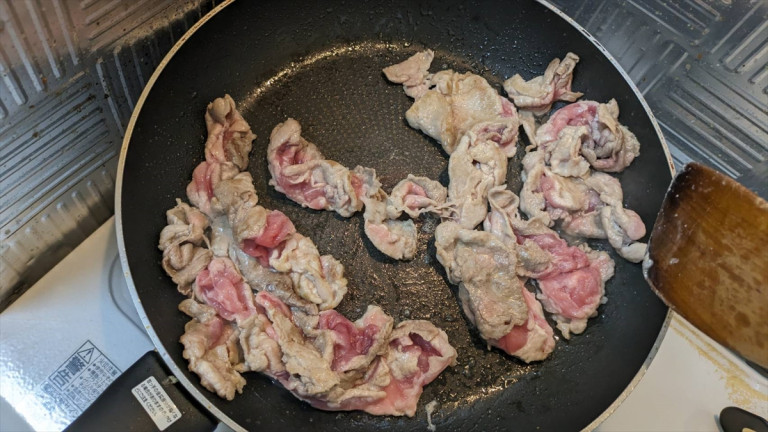

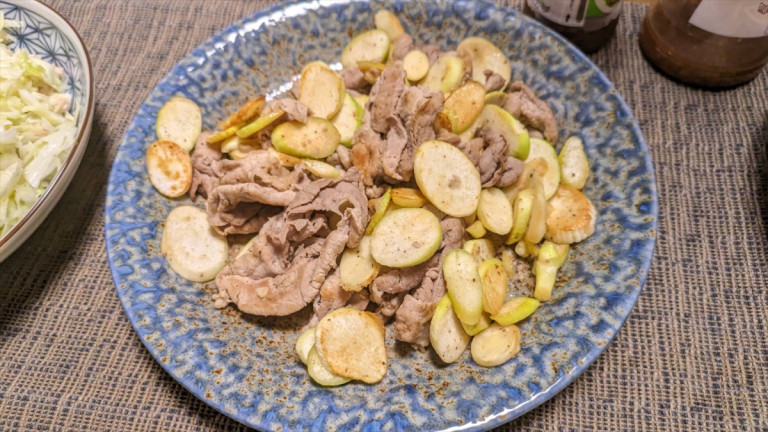

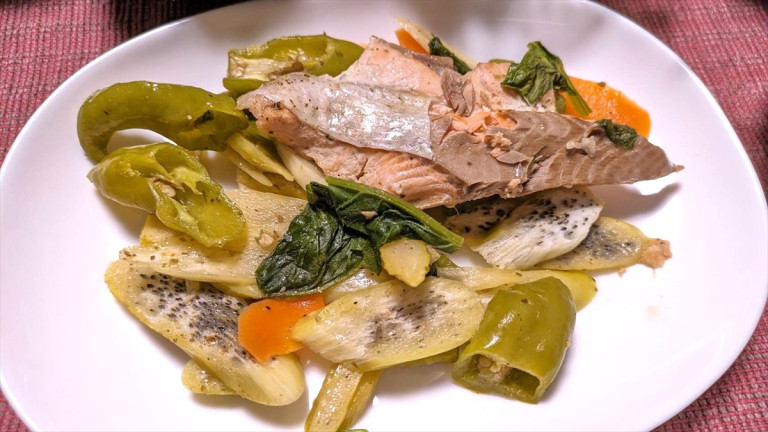
 How to make no-rice “fried rice”【SoraKitchen】
How to make no-rice “fried rice”【SoraKitchen】 Are 100 yen shop Daiso’s Japanese radish seeds worth your time? Let’s find out【Experiment】
Are 100 yen shop Daiso’s Japanese radish seeds worth your time? Let’s find out【Experiment】 We hunt for Dom Pérignon in these wine fukubukuro lucky bag boxes from Kaldi
We hunt for Dom Pérignon in these wine fukubukuro lucky bag boxes from Kaldi Gamer-friendly, non-instant yakisoba you can eat with your fingers【Sora Kitchen】
Gamer-friendly, non-instant yakisoba you can eat with your fingers【Sora Kitchen】 We visit a train station in historical ninja town, see ninja trick art, and become ninjas ourselves
We visit a train station in historical ninja town, see ninja trick art, and become ninjas ourselves Seaside scenery, history, and so many desserts on Yokohama’s Akai Kutsu【Japan Loop Buses】
Seaside scenery, history, and so many desserts on Yokohama’s Akai Kutsu【Japan Loop Buses】 Foreigner’s request for help in Tokyo makes us sad for the state of society
Foreigner’s request for help in Tokyo makes us sad for the state of society Japanese city loses residents’ personal data, which was on paper being transported on a windy day
Japanese city loses residents’ personal data, which was on paper being transported on a windy day Should you add tartar sauce to Japanese curry rice? CoCo Ichi makes diners an unusual offer
Should you add tartar sauce to Japanese curry rice? CoCo Ichi makes diners an unusual offer Red light district sushi restaurant in Tokyo shows us just how wrong we were about it
Red light district sushi restaurant in Tokyo shows us just how wrong we were about it Ghibli Park now selling “Grilled Frogs” from food cart in Valley of Witches
Ghibli Park now selling “Grilled Frogs” from food cart in Valley of Witches Japanese ramen restaurants under pressure from new yen banknotes
Japanese ramen restaurants under pressure from new yen banknotes Smash Bros. director Sakurai stabs Kirby in the face, has delicious justification for it
Smash Bros. director Sakurai stabs Kirby in the face, has delicious justification for it Amazing exhibition of Japan’s legendary “cursed katana” is going on right now【Photos】
Amazing exhibition of Japan’s legendary “cursed katana” is going on right now【Photos】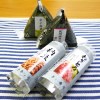 The madness ends now: How to conqueror impossible-to-open Japanese convenience store snacks
The madness ends now: How to conqueror impossible-to-open Japanese convenience store snacks McDonald’s new Happy Meals offer up cute and practical Sanrio lifestyle goods
McDonald’s new Happy Meals offer up cute and practical Sanrio lifestyle goods French Fries Bread in Tokyo’s Shibuya becomes a hit on social media
French Fries Bread in Tokyo’s Shibuya becomes a hit on social media Studio Ghibli releases new action figures featuring Nausicaä of the Valley of the Wind characters
Studio Ghibli releases new action figures featuring Nausicaä of the Valley of the Wind characters New private rooms on Tokaido Shinkansen change the way we travel from Tokyo to Kyoto
New private rooms on Tokaido Shinkansen change the way we travel from Tokyo to Kyoto Tokyo Tsukiji fish market site to be redeveloped with 50,000-seat stadium, hotel, shopping center
Tokyo Tsukiji fish market site to be redeveloped with 50,000-seat stadium, hotel, shopping center Beautiful Ghibli sealing wax kits let you create accessories and elegant letter decorations【Pics】
Beautiful Ghibli sealing wax kits let you create accessories and elegant letter decorations【Pics】 Studio Ghibli releases Kiki’s Delivery Service chocolate cake pouches in Japan
Studio Ghibli releases Kiki’s Delivery Service chocolate cake pouches in Japan New definition of “Japanese whiskey” goes into effect to prevent fakes from fooling overseas buyers
New definition of “Japanese whiskey” goes into effect to prevent fakes from fooling overseas buyers Our Japanese reporter visits Costco in the U.S., finds super American and very Japanese things
Our Japanese reporter visits Costco in the U.S., finds super American and very Japanese things All-you-can-drink Starbucks and amazing views part of Tokyo’s new 170 meter-high sky lounge
All-you-can-drink Starbucks and amazing views part of Tokyo’s new 170 meter-high sky lounge More foreign tourists than ever before in history visited Japan last month
More foreign tourists than ever before in history visited Japan last month New Pokémon cakes let you eat your way through Pikachu and all the Eevee evolutions
New Pokémon cakes let you eat your way through Pikachu and all the Eevee evolutions Disney princesses get official manga makeovers for Manga Princess Cafe opening in Tokyo
Disney princesses get official manga makeovers for Manga Princess Cafe opening in Tokyo Sales of Japan’s most convenient train ticket/shopping payment cards suspended indefinitely
Sales of Japan’s most convenient train ticket/shopping payment cards suspended indefinitely Sold-out Studio Ghibli desktop humidifiers are back so Totoro can help you through the dry season
Sold-out Studio Ghibli desktop humidifiers are back so Totoro can help you through the dry season Japanese government to make first change to romanization spelling rules since the 1950s
Japanese government to make first change to romanization spelling rules since the 1950s Ghibli founders Toshio Suzuki and Hayao Miyazaki contribute to Japanese whisky Totoro label design
Ghibli founders Toshio Suzuki and Hayao Miyazaki contribute to Japanese whisky Totoro label design Doraemon found buried at sea as scene from 1993 anime becomes real life【Photos】
Doraemon found buried at sea as scene from 1993 anime becomes real life【Photos】 Tokyo’s most famous Starbucks is closed
Tokyo’s most famous Starbucks is closed One Piece characters’ nationalities revealed, but fans have mixed opinions
One Piece characters’ nationalities revealed, but fans have mixed opinions We asked a Uniqlo employee what four things we should buy and their suggestions didn’t disappoint
We asked a Uniqlo employee what four things we should buy and their suggestions didn’t disappoint Princesses, fruits, and blacksmiths: Study reveals the 30 most unusual family names in Japan
Princesses, fruits, and blacksmiths: Study reveals the 30 most unusual family names in Japan Mr Sato takes a trip to Twitter Japan’s lunch room, gorges on their special menu
Mr Sato takes a trip to Twitter Japan’s lunch room, gorges on their special menu Do you know what this caterpillar-like food is? We had no idea!【Taste test】
Do you know what this caterpillar-like food is? We had no idea!【Taste test】 Netizen visits grandparents’ house, finds undisturbed bamboo stalk growing in the kitchen【Pics】
Netizen visits grandparents’ house, finds undisturbed bamboo stalk growing in the kitchen【Pics】 Weird Japanese vending machine find gives us unique sweet potato sweets
Weird Japanese vending machine find gives us unique sweet potato sweets The defrosted reality of 24 frozen meals at Thai 7-Elevens [Photos]
The defrosted reality of 24 frozen meals at Thai 7-Elevens [Photos] Visit a pepper-packed tribute to spiciness tucked away in an Osaka food court
Visit a pepper-packed tribute to spiciness tucked away in an Osaka food court Ramen shop in Nagoya offers monster servings of mouth-watering bamboo shoots as toppings
Ramen shop in Nagoya offers monster servings of mouth-watering bamboo shoots as toppings Chinese restaurant has the most epic English menu of all time
Chinese restaurant has the most epic English menu of all time Is a camping toaster from Daiso any good? We tested one so you don’t have to!
Is a camping toaster from Daiso any good? We tested one so you don’t have to! Do people in Osaka really eat crunchy fried noodles with curry? We ask a local, then try it out
Do people in Osaka really eat crunchy fried noodles with curry? We ask a local, then try it out Making a traditional Japanese dessert from “heaven grass”【Photos】
Making a traditional Japanese dessert from “heaven grass”【Photos】 Can slapping on some nose filters prevent the anguish of hay fever?
Can slapping on some nose filters prevent the anguish of hay fever? Japanese actress wows in stunning edible dress made of vegetable slices【Video】
Japanese actress wows in stunning edible dress made of vegetable slices【Video】 Vending machine noodle ice cream: A retro icon in Japan brings joy to a new generation
Vending machine noodle ice cream: A retro icon in Japan brings joy to a new generation Making spicy instant ramen fried rice, Korea’s latest viral food trend【SoraKitchen】
Making spicy instant ramen fried rice, Korea’s latest viral food trend【SoraKitchen】
Leave a Reply